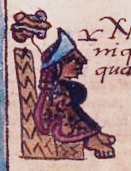Andrés de Tapia Motelchiuh on:
[Wikipedia]
[Google]
[Amazon]
 Don Andrés de Tapia Motelchiuh Huitznahuatlailótlac, also known as Motelchiuhtzin, was the ruler of Tenochtitlan (1525–1530).
After the death of Don Juan Velázquez Tlacotzin in Nochixtlan in 1525,
Don Andrés de Tapia Motelchiuh Huitznahuatlailótlac, also known as Motelchiuhtzin, was the ruler of Tenochtitlan (1525–1530).
After the death of Don Juan Velázquez Tlacotzin in Nochixtlan in 1525,
 Don Andrés de Tapia Motelchiuh Huitznahuatlailótlac, also known as Motelchiuhtzin, was the ruler of Tenochtitlan (1525–1530).
After the death of Don Juan Velázquez Tlacotzin in Nochixtlan in 1525,
Don Andrés de Tapia Motelchiuh Huitznahuatlailótlac, also known as Motelchiuhtzin, was the ruler of Tenochtitlan (1525–1530).
After the death of Don Juan Velázquez Tlacotzin in Nochixtlan in 1525, Hernán Cortés
Hernán Cortés de Monroy y Pizarro Altamirano, 1st Marquess of the Valley of Oaxaca (; ; 1485 – December 2, 1547) was a Spanish ''conquistador'' who led an expedition that caused the fall of the Aztec Empire and brought large portions of w ...
chose Don Andrés Motelchiuhtzin as the new ruler of Tenochtitlan
, ; es, Tenochtitlan also known as Mexico-Tenochtitlan, ; es, México-Tenochtitlan was a large Mexican in what is now the historic center of Mexico City. The exact date of the founding of the city is unclear. The date 13 March 1325 was ...
.
Motelchiuhtzin was not of the upper classes; he was born as a " macehualli" or working commoner, but he had gained renown as a warrior captain. He was captured together with Cuauhtémoc
Cuauhtémoc (, ), also known as Cuauhtemotzín, Guatimozín, or Guatémoc, was the Aztec ruler ('' tlatoani'') of Tenochtitlan from 1520 to 1521, making him the last Aztec Emperor. The name Cuauhtemōc means "one who has descended like an eagle ...
, and torture
Torture is the deliberate infliction of severe pain or suffering on a person for reasons such as punishment, extracting a confession, interrogation for information, or intimidating third parties. Some definitions are restricted to acts ...
d along with him to reveal the location of the Aztec
The Aztecs () were a Mesoamerican culture that flourished in central Mexico in the post-classic period from 1300 to 1521. The Aztec people included different ethnic groups of central Mexico, particularly those groups who spoke the Nahuatl ...
s' gold
Gold is a chemical element with the symbol Au (from la, aurum) and atomic number 79. This makes it one of the higher atomic number elements that occur naturally. It is a bright, slightly orange-yellow, dense, soft, malleable, and ductile ...
. Eventually he was freed and he returned to his lands.
Because Tenochtitlan was in ruins, he stayed in Nochixtlan. In the three years of Cortés expeditions, he had been ruling Tenochtitlan as ''cuauhtlatoani''. He would not be tlatoani
''Tlatoani'' ( , "one who speaks, ruler"; plural ' or tlatoque) is the Classical Nahuatl term for the ruler of an , a pre-Hispanic state. It is the noun form of the verb "tlahtoa" meaning "speak, command, rule". As a result, it has been variousl ...
, but he would stayed as ''cuauhtlatoani'' two years more.
During his rule, the Aztec titles and decorations were suppressed by the Spanish rulers.
In 1530, Motelchiuhtzin went with the Spaniards to an expedition to Teocolhuacan, against the Chichimeca
Chichimeca () is the name that the Nahua peoples of Mexico generically applied to nomadic and semi-nomadic peoples who were established in present-day Bajio region of Mexico. Chichimeca carried the meaning as the Roman term "barbarian" that d ...
and in Aztatlan was wounded by a Chichimecan arrow while he was bathing, and died of the wound. He left a son called Hernando de Tapia.
(Bowditch 1904) identifies this person simply as Motelchiuh, and says he was named for "his godfather, Don Andrés de Tapia Motelchiuh". This presumably refers to the Spanish conquistador Don Andrés de Tapia
Andrés de Tapia (1498? - October 1561) was a Spanish soldier and chronicler. He participated in the Spanish conquest of the Aztec Empire
The Spanish conquest of the Aztec Empire, also known as the Conquest of Mexico or the Spanish-Aztec War ( ...
, and probably should read "his godfather, Don Andrés de Tapia".
See also
*List of Tenochtitlan rulers
This is a list of Mesoamerican rulers of the ''altepetl'' of Tenochtitlan (modern Mexico City) from its foundation in 1325 until the end of the line of indigenous rulers. From c. 1375 onwards, the rulers of Tenochtitlan were monarchs and used the ...
References
*''Anales de Tlatelolco
The ''Anales de Tlatelolco'' (''Annals of Tlatelolco'') is a codex manuscript written in Nahuatl, using Latin characters, by anonymous Aztec authors. The text has no pictorial content. Although there is an assertion that the text was a copy of one ...
'' (1540)
External links
Tenochca tlatoque 16th-century monarchs in North America 16th-century indigenous people of the Americas 16th-century Mexican people Year of birth missing 1530 deaths {{mesoamerica-stub